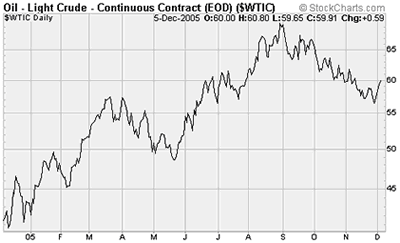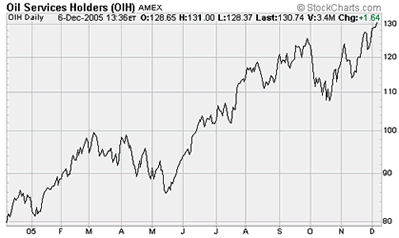| Home | About Us | Resources | Archive | Free Reports | Market Window |
What The Big Money is Doing NowBy
Thursday, December 8, 2005
In 1970, at the Institutional Investors’ Conference, two thousand of the nation’s top money mangers were asked to name the stock that would perform best in the coming year. They selected National Student Marketing. National Student Marketing fell from $140 to $7 over the next 5 months. In 1970, investors were obsessed with stocks, especially ‘growth stocks’ like NSM. It didn’t matter if a stock’s p/e ratio was 50... 75... or 100. Investors expected well-known companies like Xerox and IBM to grow to the sky. Nine years later, the Dow Jones Industrial Average was below levels seen in 1929, adjusted for inflation. Xerox lost two-thirds of its value in just two years (1973-74), and still traded at those levels in 1980. The crowd was wrong. While stocks (especially growth stocks like Xerox) crumbled during the 70s, commodities soared. For example... in 1969, oil traded for $1.70 a barrel. It seemed expensive. Experts argued it would fall to $1. Even after the ten-dollar spike in 1973, the famous economist Milton Friedman wrote that oil would soon be back below $2. Between June 1970 and June 1980, oil increased 1866%, and almost hit $50 a barrel. In addition to oil, other “real stuff” investments clobbered the returns on stocks. Between 1970 and 1980, U.S. rare coins returned 1052%. Stamps gained 619%. Diamonds returned 315%. U.S. farmland increased 270%. How many investors in 1969 do you think were buying crude oil investments? Or rare gold coins? Or stamps? Or investment grade diamonds? Answer: Not many... they were still concerned with stocks. I’m not arguing for a repeat of the 70s. I’m just trying to show that investors are always on the wrong side of the big opportunities.
By 1980, the tables had turned. Investors were crazy about collectibles and precious metals. You’d pick up the phone and someone you’d never spoken to would try to sell you stamps... or gold coins. I went to the library and read back issues of The New York Times from the late 70s. I saw stories of alchemy, tin ingot heists, and long, boisterous lines at antique stores. At the same time, BusinessWeek ran the now-famous declaration, “Equities are Dead!” on their front cover. But what was the right place to be – in hard assets or in equities? You already know the answer to that one. The cycle has turned again, starting in 2000. After a 20-year bull market in stocks and bonds, investors were crazy about Wall Street’s paper assets – stocks and bonds. But hard assets – metals, natural resources and scarce collectibles – had drooped off the radar. And wouldn’t you believe it, investors were caught napping... again! Stocks haven’t gone anywhere for 5 years. Yet on Tuesday, aluminum hit an 11-year high, zinc a 15-year high, lead a 25-year high, silver an 18-year high and gold a 24-year high. I don’t have to tell you what oil has done in the past few years. The conclusion is simple. If you want to make the triple digit returns, year after year, forget the big money stocks that investors loved in the late 90s. Their time in the sun has passed for the moment. For the big money, buy hard assets, commodities, and collectibles... and be prepared to hold onto them for a long time. Good Investing, Tom Dyson Market NotesMARKET NOTES After declining in sympathy with crude oil during October, the companies who help find and extract hydrocarbons are surging to new highs. Below is a one-year chart showing crude’s correction: |
Recent Articles
|



